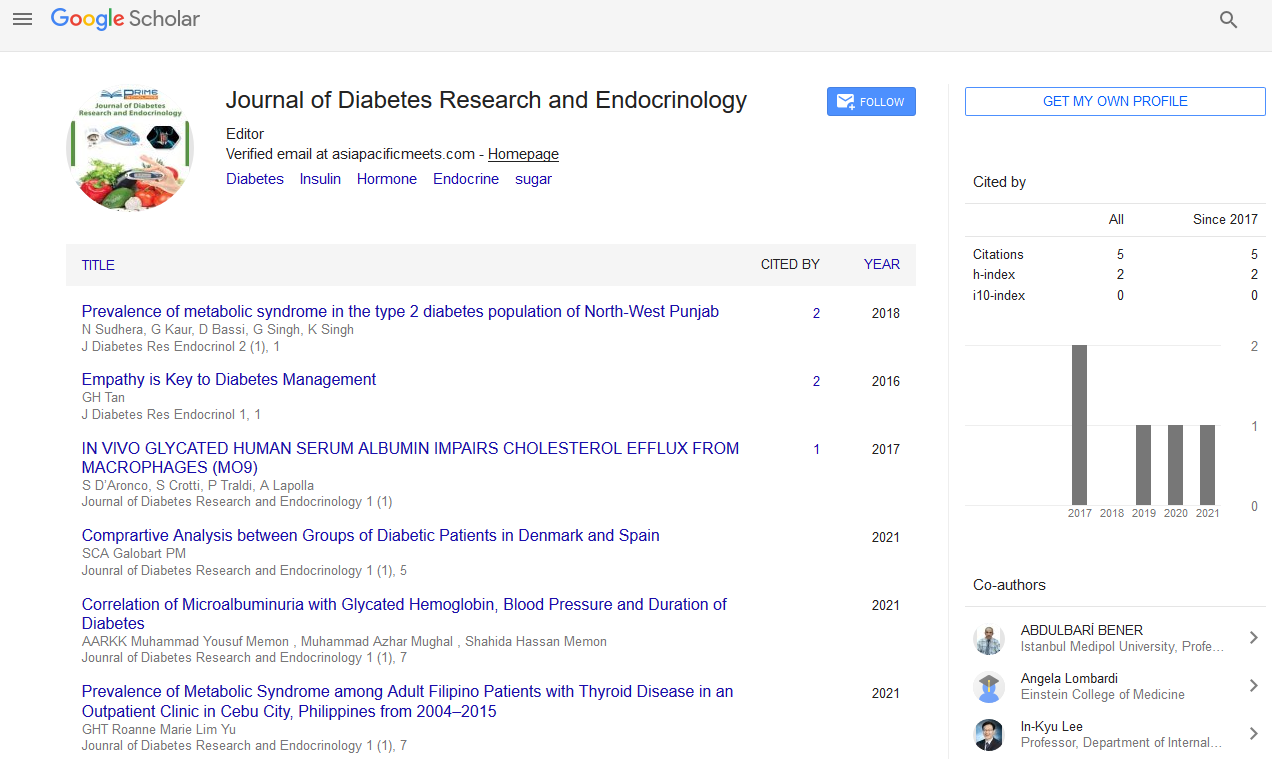Perspective - (2023) Volume 7, Issue 1
The Beta Cells of the Islets of Langerhans in the Pancreas make Insulin, an Anabolic Hormone
Victoria L Tokarz*
Department of Biomedical Sciences, Ulster University, UK
*Correspondence:
Victoria L Tokarz,
Department of Biomedical Sciences, Ulster University,
UK,
Email:
Received: 02-Jan-2023, Manuscript No. IPJDRE-23-16122;
Editor assigned: 04-Jan-2023, Pre QC No. IPJDRE-23-16122 (PQ);
Reviewed: 18-Jan-2023, QC No. IPJDRE-23-16122;
Revised: 23-Jan-2023, Manuscript No. IPJDRE-23-16122 (R);
Published:
30-Jan-2023, DOI: 10.36648/ipjdre.7.1.02
Introduction
A high blood concentration of salt, sodium, glucose, and other
substances is this condition. The brain, along with the rest of
the body’s organs, is drained of water as a result. Risk factors
consist of: A stressful circumstance like an infection, a heart
attack, stroke, or recent surgery. Hyperosmolar hyperglycemic
state is a serious inconvenience of diabetes that happens when
glucose levels are exceptionally high for a significant stretch of
time. Extreme thirst, frequent urination, and confusion are all
possible signs of HHS. A clinical condition known as Hyperosmolar
Hyperglycemic Syndrome (HHS) is the result of a diabetes
mellitus complication. Type 2 diabetes represents around
90% to 95% of diabetes cases. Patients with obesity are most
likely to experience it. Ordinarily, the kidneys attempt to compensate
for a high glucose level in the blood by permitting the
additional glucose to leave the body in the pee. However, the
body also loses water as a result. You can become severely dehydrated
if you don’t drink enough water, consume sugar-laden
beverages, or continue to eat carbohydrates.
Description
The kidneys are no longer able to eliminate the extra glucose
in this situation. As a result, your blood glucose level can rise
to levels that are extremely high, sometimes exceeding 10
times normal. HHS happens when exceptionally high glucose
prompts extreme drying out and profoundly thought blood
high osmolality, which are perilous. Additionally, HHS involves
a lack of insulin, but the individual typically produces sufficient
insulin to prevent ketosis. In addition, the high blood sugar is
frequently brought on by an underlying condition, such as an
infection. The principal distinction among DKA and HHS is that
DKA includes ketones and blood causticity; The HHS doesn’t.
The two complications share a number of symptoms, including
changes in mental state, frequent urination, and intense
thirst. Researchers have difficulty estimating the prevalence
of HHS, but in comparison to other diabetes-related complications,
they believe it to be relatively uncommon. According to
some studies, HHS is responsible for about 1% of all diabetes
hospital admissions. Diabetics with severe hyperglycemia and
glycosuria do not exhibit the typical Kussmaul breathing or the
presence of acetone in the urine seen in diabetic ketoacidosis.
This clinical condition was previously called non-ketotic hyperglycemic
trance state, hyperosmolar hyperglycemic non-ketotic
disorder, and hyperosmolar non-ketotic extreme lethargies
(Sound). Hyperglycemia is the primary metabolic disorder in
diabetes mellitus, a clinical condition. An absolute or relative
insulin deficiency is to blame for this. The beta cells of the islets
of Langerhans in the pancreas make insulin, an anabolic hormone.
The fundamental capability of this chemical is to bring
down the degree of glucose in the blood by advancing the takeup
of glucose by the fat tissue and skeletal muscle, known as
glycogenesis.
Conclusion
Lipolysis, the process by which fat in the adipose tissue is broken
down, is also inhibited by insulin. Hormones like glucagon
and catecholamines counteract insulin’s metabolic effects.
Alternate states of consciousness, ranging from confusion or
disorientation to coma, are the primary signs of a hyperosmolar
hyperglycemic state. These states typically occur as a result
of extreme dehydration combined with or without prerenal
azotemia, hyperglycemia, and hyper osmolality. In contrast to
diabetic ketoacidosis, transient hemiplegia and focal or generalized
seizures may occur.
Citation: Tokarz VL (2023) The Beta Cells of the Islets of Langerhans in the Pancreas make Insulin, an Anabolic Hormone. J Diab
Res Endocrinol. 7:02.
Copyright: © 2023 Tokarz VL. This is an open-access article distributed under the terms of the Creative Commons Attribution
License, which permits unrestricted use, distribution, and reproduction in any medium, provided the original author and source
are credited.

